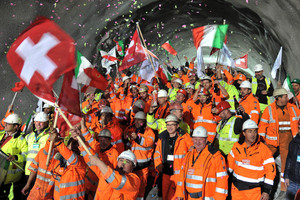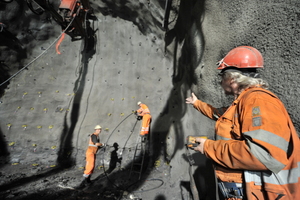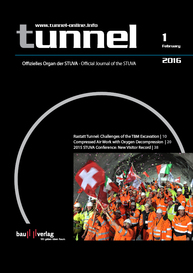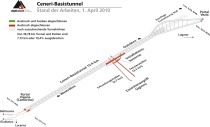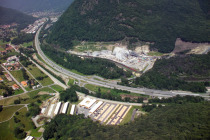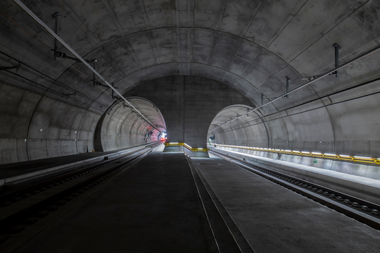Breakthroughs in both Ceneri Base Tunnel Tubes
The main breakthrough took place in the western bore of the Ceneri Base Tunnel on January 21, 2016. Shortly after this final round of blasting the tunnellers were able to exchange handshakes. The inner lining of the tunnel is due to follow in the months to come together with installation of the rail engineering work. The 15.4 km long Ceneri Base Tunnel is scheduled to become operational in late 2020.
Some 700 m from the north portal in Camorino more than 1000 people involved in the project including tunnellers, contractors, engineers, planners, geologists and surveyors joined the guests of honour to witness the final round of blasting in the Ceneri Base Tunnel’s western tube. The breakthrough was executed with high precision. The lateral deviation amounted to 2 cm with a 1 cm discrepancy in height. The second breakthrough was undertaken on January 26, 2016 in the eastern bore.
Renzo Simoni, the CEO of the AlpTransit Gotthard AG, expressed his thanks to all those involved in the project and especially the tunnellers for their outstanding achievement, while also recalling the two tunnellers, who lost their lives during the construction of the Base Tunnel. Peter Füglistaler, the director of the FOT (Federal Office of Transport) stressed that the Ceneri Base Tunnel’s significance extended far beyond the Canton of Ticino and Switzerland: “Switzerland represents a model for Europe by consistently transferring goods crossing the Alps from road to rail”.
Building the Ceneri Base Tunnel
Just like the Gotthard Base Tunnel, the Ceneri Base Tunnel comprises two single-track bores, which are linked at 325 m gaps by 40 m long cross-passages. On account of its length no gauge conversion or emergency halts are necessary. The Ceneri Base Tunnel was produced solely by drill and blast owing to the complex geology. The maximum rock overburden ranged up to 900 m, the minimum distance to only a few metres. The bulk of the excavation took place simultaneously from the Sigirino intermediate point-of-attack in both directions. Counter-drives were undertaken from the Vigana and Vezia portals to cut down on time and costs. Altogether, around eight million tonnes of material were excavated during the production of the Ceneri Base Tunnel.
Initial preparatory work took place back in 1997 with the building of the 3.1 km long exploratory tunnel. In 2008, a tunnel boring machine drove a 2.3 km long access tunnel. Two underground caverns are located at the end of this tunnel, which became the starting points for the main drives towards the south and north as from 2010.
Next Working Steps
The main breakthrough does not mean that work on the Ceneri Base Tunnel is completed. In the months ahead the tunnel’s inner lining will be further developed. By late 2016, all tunnels and passages will be lined and concreted. The specialists for completing the roughwork furnishings will equip the tunnel with mechanical and electromechanical systems such as doors, gates, ventilation and technical installations. In summer 2017, work will start on installing the rail engineering including the track, overhead line, traction current and power supply, cable, telecommunications and radio systems, safety and automation facilities as well as the control technology.

